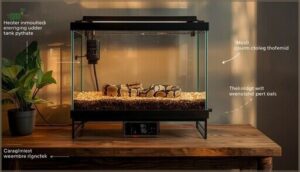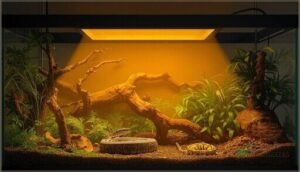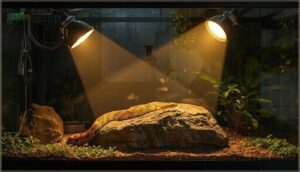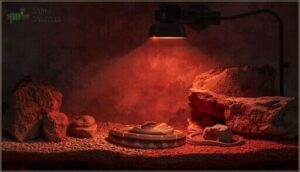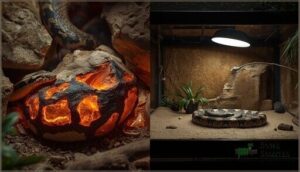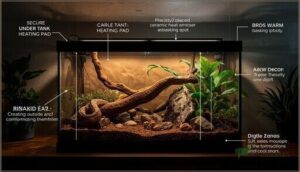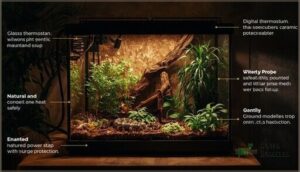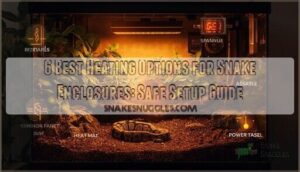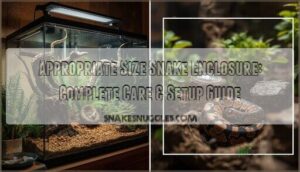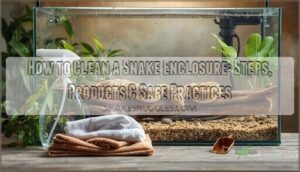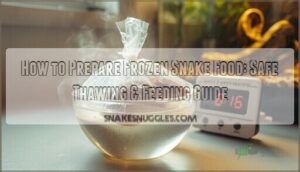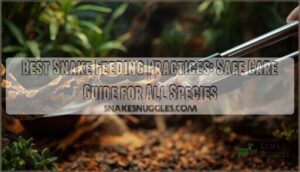This site is supported by our readers. We may earn a commission, at no cost to you, if you purchase through links.

The problem isn’t just using the wrong equipment—it’s combining multiple heating devices without proper controls, placing heat sources where snakes can press against them for hours, or trusting a single thermostat to manage complex temperature zones.
Getting your heating setup right means understanding not just which devices work, but how to layer them safely, position them strategically, and monitor them consistently. The difference between a thriving snake and a veterinary emergency often comes down to a few critical setup decisions and the right safety equipment backing them up.
Table Of Contents
Key Takeaways
- Always use thermostats and protective barriers with heating devices to prevent burns and overheating in your snake’s enclosure.
- Set up a clear temperature gradient in the habitat, giving your snake warm and cool zones for healthy thermoregulation.
- Avoid unsafe devices like hot rocks and never place heat sources where your snake can touch them directly.
- Check heating equipment and sensors often, and match temperature and humidity levels to your snake’s species and life stage.
Essential Heating Requirements for Snake Habitats
Getting your snake’s habitat heated just right is more than finding a warm spot. The right setup means understanding what snakes need and how each heating option works.
Let’s walk through the common choices so you can pick what’s best for your reptile.
Importance of Temperature Gradients
A well-set temperature gradient in your snake enclosure is the backbone of reptile heating. It lets snakes move between warm and cool zones, supporting behavioral thermoregulation. This balance is key for metabolic efficiency, digestive health, and immune function.
A proper temperature gradient is the backbone of snake care, enabling healthy thermoregulation and metabolic function
With thermostatic control, a single heat source can keep your snake thriving while optimizing both growth and stress reduction. Thermal gradient designs greatly impact thermoregulation studies.
Optimal Temperature Ranges for Snakes
Understanding ideal temperatures helps you set safe reptile heating zones. Most snakes prefer 26°C to 33°C as their thermal preference range, supporting metabolic impact on digestion and immunity. Temperature requirements for snakes vary by habitat variation:
- Tropical species thrive at 27°C to 38°C
- Temperate snakes prefer 20°C to 35°C
- Basking spots should reach 32°C, with cool zones at 24-27°C
The importance of thermostats ensures proper temperature control while preventing dangerous overheating. Ensuring proper full-spectrum lighting is also key for reptile health. Humidity influence also affects how snakes regulate their body heat.
Species-Specific Heating Needs
Not all snakes share the same thermal preferences. Ball pythons need their warm side at 88-96°F, while corn snakes thrive at 85-90°F. Boa constrictors require slightly higher metabolic rates, preferring 88-95°F.
Hatchling needs often demand warmer, more consistent temperatures than adults. Nocturnal heating matters for species like ball pythons—ceramic heat emitters provide warmth without light disruption.
Seasonal adjustments support reptile thermoregulation needs throughout the year, ensuring suitable temperatures match species-specific requirements.
Role of Humidity in Temperature Control
Humidity gradients work hand-in-hand with temperature control in your snake’s enclosure. When humidity levels sit between 60-75%, substrate moisture stabilizes surface temperatures and reduces evaporative cooling.
Ball pythons need 70-85% humidity on the cool side to support proper thermoregulation. Place your hygrometer midway up the wall for accurate readings.
Without humidity control, snakes may experience thermal depression, lowering their body temperature to conserve water.
Safe Heating Devices for Snake Enclosures
Choosing the right heating device for your snake’s enclosure can feel overwhelming with all the options out there. Each type of heater brings its own benefits and safety considerations.
Here’s what you need to know about the most reliable choices for your setup.
Heat Mats and Under Tank Heaters (UTH)
Heat mats and under tank heaters (UTH) offer a budget-friendly way to warm your snake’s habitat, but they come with a catch. Without a thermostat, these heat pads can exceed 120°F and cause serious burns. Always use thermostat reliance and safe installation practices—mount externally, not inside.
Substrate impact matters too: 1.5 to 3 inches helps distribute heat evenly, improving UTH effectiveness while supporting burn prevention.
Ceramic Heat Emitters
Ceramic heat emitters work as a reliable heat source, converting 100% of electrical energy into far-infrared warmth that aids digestion and circulation. While they last over 5 years, safety risks demand attention:
- Always use thermostat controls to prevent overheating
- Install in ceramic-rated fixtures with protective guards
- Position 8+ inches from accessible surfaces
- Monitor humidity impact—they can dry out enclosure heating zones
- Follow installation guidelines to avoid fire hazards
Radiant Heat Panels
Mounting radiant heat panels overhead offers a safer alternative to undertank heaters, delivering infrared warmth without direct contact risks. These panels create stable temperature gradient control across your enclosure. Panel safety features include flame-retardant construction and thermal fuses, while their 10+ year panel lifespan and lower energy cost savings outperform ceramic heat emitters when paired with quality thermostats.
Installation best practices require secure ceiling mounting with electrical connections outside the enclosure—flush designs prevent snakes from accessing hot surfaces, reducing burn incidents markedly compared to other reptile heating methods. Always use temperature control devices to prevent overheating.
| Panel Wattage | Enclosure Size | Typical Gradient |
|---|---|---|
| 40W | Up to 2×4 ft | 75-90°F |
| 80W | 4x2x2 ft (120 gal) | 80-90°F |
| 120W | 2×6 ft or larger | 75-92°F |
| Multiple panels | Custom builds | Species-specific |
| Any wattage | Requires thermostat | Prevents spikes |
A 40-watt unit maintains proper zones in smaller setups, while 80-watt models handle 120-gallon habitats.
Halogen and Basking Bulbs
When you need focused warmth for your snake’s basking area, halogen flood lights and basking bulbs deliver concentrated heat output with impressive bulb efficiency. A 40W halogen can push basking spots to 101°F at 12 inches, while 60W models reach 115°F—energy savings of up to 40% compared to older heat lamps. Their lighting spectrum mimics natural sunlight, encouraging healthy thermoregulation.
But burn prevention demands external mounting with guards; never place heat bulbs inside enclosures where snakes can contact them.
Deep Heat Projectors
Deep Heat Projectors blend infrared heating with superior heat penetration, pushing warmth into substrate and décor, not just ambient air. Unlike ceramic heat emitters, DHPs emit infrared-A and infrared-B, mimicking natural sunlight and warming muscle tissue deeply. They’re ideal for thermal gradients in snake habitats:
- 50W models heat basking surfaces to 90°F at 12 inches
- 80W units reach 107°F at the same distance
- Lifespan exceeds 10,000 hours
- Energy efficiency cuts electricity costs by 20%
- No visible light—perfect for nighttime temperature control
Position your heat source with proper fixtures and always pair it with a thermostat for reliable reptile heating equipment performance.
Dangers of Hot Rocks and Unsafe Devices
Hot rocks top the list of unsafe heating devices—they’ve caused thermal injury in 72% of reptile burn cases. Surface temperatures can spike past 150°F during malfunctions, creating severe hot rock hazards your snake can’t sense. Without thermostats, burn risk factors multiply fast.
Stick with heat mats, basking bulbs, or heat lamps paired with proper fire safety controls for reliable reptile burn prevention.
Proper Installation and Placement Techniques
Installing your heating equipment correctly makes all the difference between a safe, comfortable habitat and a potential hazard. Where you place heat sources and how you secure them directly impacts your snake’s ability to thermoregulate without risk of burns or overheating.
Let’s walk through the key installation techniques that keep your setup both effective and safe.
Creating Effective Temperature Zones
By positioning your heat source on just one side of the snake enclosure, you’ll establish the temperature gradient your snake needs to thrive. Here’s how to design effective temperature zones:
- Dedicate one-third of the habitat to a basking zone at 85ºF–90ºF
- Maintain the cool zone at 75ºF–82ºF on the opposite end
- Place hides at both warm and cool ends for refuge
- Use thermostats with probes at multiple points for thermal monitoring
- Adjust substrate depth to fine-tune microclimate impact around resting spots
Safe Positioning of Heating Elements
Where you install your heat source makes all the difference between a safe habitat and a dangerous one. Mount radiant panels to the tank’s top interior, while heat mats work best beneath hides, covered by about 2 inches of substrate for burn prevention.
Always connect heating elements to thermostats and position probes directly in warm zones. Secure UTH placement with heat-resistant tape to prevent shifting and maintain gradient creation while ensuring electrical safety.
Using Protective Barriers and Fixtures
Protective barriers act as your first line of defense against thermal burns. Use 1/4 inch hardware mesh cages around heat bulbs and basking bulbs, preventing direct contact while allowing heat distribution. Metal brackets with ventilation work well for ceramic emitters in PVC enclosures.
- Hardware mesh guards reduce burn incidents by over 80% in reported cases
- Heat lamp fixtures with integrated cages improve ventilation and safety
- Secure mounting with wide-head screws prevents fixture collapse
- Pair all barrier materials with thermostats for complete burn prevention
Overhead Vs. Under Tank Heating Systems
Burn prevention doesn’t stop at barriers—choosing the right heat source changes everything. Overhead heating warms air and surfaces, mimicking sunlight, while under tank heating targets local spots with heat mats. To help you compare, here’s a quick snapshot:
| Heat Source | Thermal Efficiency | Safety Features |
|---|---|---|
| Overhead Heating | Broad, even coverage | Less direct burn risk |
| Under Tank Heating | Localized, hot spots | Needs constant checks |
| Combined Systems | Best of both worlds | Requires thermostat |
| Energy Costs | Overhead higher | Mats use less power |
| Installation Tips | Secure, needs fixtures | Monitor with sensors |
Preventing Overheating and Ensuring Fire Safety
Even the best heating device can become dangerous without proper safeguards. Overheating, electrical failures, and fire risks are real concerns that every snake keeper needs to address before problems arise. Let’s walk through the essential safety measures that’ll protect both you and your snake.
Importance of Thermostats and Controllers
Think of a thermostat as your snake’s safety net—it automatically cuts power when temperatures climb too high, preventing burns and even fires.
Thermostats offer accuracy within ±1°F, ensuring your heat source maintains the proper temperature gradient your snake needs. Without one, unregulated heating can exceed 120°F, risking serious injury.
Plus, they boost energy efficiency while protecting your animal.
Regular Inspection and Maintenance
Regular visual inspections of your heating system dramatically reduce fire safety risks and extend device longevity. Check your setup monthly—industry pros do this in 78% of facilities—and watch for failure signs:
- Frayed cords or discoloration on heating elements
- Scorch marks or burned substrate beneath mats
- Flickering lights or unusual sounds from controls
- Temperature swings outside your target range
Calibration frequency matters too—test digital thermometers every six months. Record keeping helps track patterns and prevents heating element safety issues before they escalate.
Managing Electrical and Water Risks
Water and electricity don’t mix—especially near heating systems. Install GFCI outlets to detect faults within 1/40th of a second, cutting electrocution risks dramatically.
Position heaters away from water dishes, secure cords above floor level with drip loops, and use surge-protected power strips. Shallow dishes prevent spills, while backup monitors add safety redundancy.
These fire safety considerations minimize heat mat and UTH risks effectively.
Fire Safety Tools for Snake Habitats
You need a solid safety net when heating equipment runs 24/7. Install smoke detectors with 10-year lifespans and position Grade 2A10BC fire extinguishers within arm’s reach of enclosures. Thermostats with flame-retardants and overload protection cut heat mat and UTH risks markedly.
Inspect cords for fraying, keep flammable clutter away from radiant heat panel safety zones, and use protective barriers around heat lamps—these tools prevent disasters before they start.
Monitoring and Adjusting Habitat Temperatures
Setting up your heating system is just the first step—keeping your snake safe means watching those temperatures closely. Even the best equipment can drift or fail, so regular checks aren’t optional.
Here’s how to monitor conditions properly and adjust when things change.
Using Accurate Thermometers and Sensors
Your thermometer is your snake’s safety net—without accurate readings, you’re flying blind. Digital thermometers outperform analog models by a wide margin, showing less than 1°C error when properly placed.
Position sensors near your snake’s resting spot, not directly beside heat sources, to capture true habitat conditions. Calibrate every 3–6 months and cross-check readings between devices.
Temperature monitoring isn’t optional—it’s how you prevent overheating and cold spots before they harm your animal.
Adjusting for Day and Night Cycles
Snakes rely on diel cycles—day-night temperature shifts—to keep their circadian rhythms and thermoregulation on track. Drop your night temperature about 10°F from the basking zone, but never below 75°F for most species.
Use ceramic heat emitters or automated heating paired with a digital thermometer and programmable thermostat to manage nocturnal heating without light disruption. Consistent thermal gradients support healthy sleep and reduce stress-related illness.
Seasonal and Life Stage Temperature Changes
Beyond day-night thermal cycles, habitat thermoregulation demands seasonal adjustments and attention to life stage needs. Your hatchlings require warmer nighttime temperatures than adults, while species variation matters—some snakes need brumation temperatures between 40°F and 55°F during winter months.
Temperature regulation throughout seasonal temperature adjustments prevents stress from temperature fluctuations. Match your heating system to your snake’s age, natural cycle, and reproductive timing for proper thermoregulation.
Troubleshooting Common Heating Issues
Once you’ve tuned temperature ranges for seasons and life stages, troubleshooting heating problems becomes a matter of detective work. Heating device failures and thermal gradient issues often start with misplaced sensors or faulty thermostats.
Stick to regular maintenance schedules, double-check your temperature control setup, and test equipment. Small steps like these keep overheating prevention, safety protocols, and consistent heating methods at the center of your routine.
Frequently Asked Questions (FAQs)
How do power outages affect snake habitat heating?
When the power goes out, your heat mats and ceramic emitters stop working immediately.
Temperature drops can happen fast, putting your snake at risk if the outage lasts more than six hours.
What backup heating options work during emergencies?
Emergency heat options include portable heaters, battery-powered heating pads, backup generators, chemical heat packs, and thermal blankets.
Low voltage heating equipment provides reliable reptile care when standard reptile heating elements fail during power outages.
Do wireless thermostats offer advantages over wired ones?
Wireless thermostats offer installation simplicity and remote adjustments without rewiring your heating system. They reduce wire clutter for safety enhancements and support smart integration for monitoring.
Though cost-effectiveness varies, quality models deliver reliable temperature control for reptile heating equipment.
How often should heating equipment be professionally serviced?
You’ll want professional servicing for your reptile heating equipment at least once a year—some thermostats and enclosure heating devices benefit from six-month checks, especially high-output units that pose greater safety risks.
Conclusion
Proper precautions prevent problems. Your snake’s survival depends on selecting safe heating options for snake habitats and installing them correctly—not just choosing the right device, but positioning it strategically, backing it with reliable thermostats, and monitoring temperatures daily.
Burns happen silently, and electrical failures strike without warning. The difference between a thriving reptile and a tragedy often comes down to one overlooked detail. Don’t trust luck when your snake’s life is on the line.
- https://talis-us.com/blogs/news/how-long-do-reptile-heat-lamps-last
- https://reptifiles.com/corn-snake-care-guide/corn-snake-temperatures-humidity/
- https://www.petmd.com/reptile/conditions/skin/thermal-burns-reptiles
- https://www.youtube.com/watch?v=PyYCqUXG1Pg
- https://petadvocacy.org/wp-content/uploads/2022/01/Snakes-Care-Sheet.pdf

